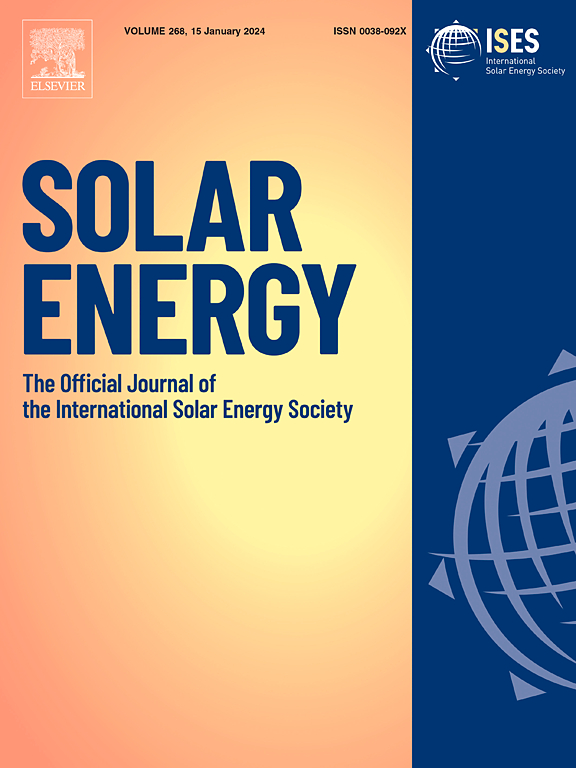Integrated design of a bio-inspired photovoltaic/thermal system with green nanofluids and composite phase change materials for semi-arid climates
IF 6
2区 工程技术
Q2 ENERGY & FUELS
引用次数: 0
Abstract
Photovoltaic/thermal (PV/T) systems urgently require solutions that simultaneously address efficiency limitations and environmental concerns. This study introduces three key innovations to address these limitations: (1) bio-inspired absorber tubes modeled after the black scorpion’s tail geometry (a previously unexplored biomimetic approach for PV/T systems), (2) Clove-functionalized MWCNT/H2O nanofluids—a new eco-friendly coolant class that simultaneously enhances heat transfer and reduces nanoparticle toxicity, and (3) Composite phase change materials (CPCMs) for surface cooling and electrical efficiency enhancement, with annual carbon dioxide emission (CO2) reduction analysis. These innovations synergistically improve performance while addressing environmental concerns—an aspect underexplored in previous PV/T research. Numerical simulations were conducted using Ansys-Fluent 2021 under transient heat flux conditions (11:00 AM to 16:00 PM) representative of a semi-arid climate (summer in Tehran- Iran), with experimental validation to ensure accuracy. The results demonstrate that the optimized helical turbulator design (Model 3) reduces average PV surface temperature by 10.2 % (to ∼43.36 °C) and increases average fluid outlet temperature by 3.85 % (to ∼32.81 °C) compared to baseline geometries. Furthermore, the use of green nanofluids at varying concentrations increases thermal and electrical efficiencies by up to 15.38 % and 1.43 %, respectively. Green nanofluids enhance thermal conductivity by ∼12.22 %, achieving a peak thermal efficiency of 75.2 % (+15.38 % improvement) and electrical efficiency of 15.23 % (+0.83 % improvement). CPCM thickness optimization (1.2 cm) further reduces PV temperature by 3.33 % while improving electrical efficiency by 1.01 %. From an environmental perspective, the system achieves substantial CO2 reductions, with Model 3 and the inclusion of C-MWCNTs/H2O: 0.175 wt% nanofluid leading to a 32.29-ton decrease (+ 143.7 % improvement) over a 15-year period.
基于绿色纳米流体和复合相变材料的半干旱气候下仿生光伏/热系统集成设计
光伏/热(PV/T)系统迫切需要同时解决效率限制和环境问题的解决方案。本研究介绍了三个关键创新来解决这些限制:(1)模仿黑蝎子尾部几何形状的仿生吸收管(PV/T系统以前未开发的仿生方法);(2)丁香功能化的MWCNT/H2O纳米流体——一种新型环保冷却剂,可同时增强传热和降低纳米颗粒毒性;(3)复合相变材料(CPCMs)用于表面冷却和提高电效率,并具有年度二氧化碳排放(CO2)减少分析。这些创新协同提高了性能,同时解决了环境问题,这是以前PV/T研究未充分探索的一个方面。利用Ansys-Fluent 2021在代表半干旱气候(伊朗德黑兰夏季)的瞬态热通量条件下(上午11:00至下午16:00)进行了数值模拟,并进行了实验验证以确保准确性。结果表明,与基线几何形状相比,优化的螺旋湍流器设计(模型3)使PV平均表面温度降低了10.2%(至~ 43.36°C),平均流体出口温度提高了3.85%(至~ 32.81°C)。此外,使用不同浓度的绿色纳米流体可使热效率和电效率分别提高15.38%和1.43%。绿色纳米流体的导热性提高了约12.22%,峰值热效率达到75.2%(提高15.38%),电效率达到15.23%(提高0.83%)。CPCM厚度优化(1.2 cm)进一步降低了PV温度3.33%,同时提高了1.01%的电效率。从环境的角度来看,该系统实现了显著的二氧化碳减排,模型3和C-MWCNTs/H2O: 0.175 wt%的纳米流体在15年的时间里减少了32.29吨(+ 143.7%)。
本文章由计算机程序翻译,如有差异,请以英文原文为准。
求助全文
约1分钟内获得全文
求助全文
来源期刊

Solar Energy
工程技术-能源与燃料
CiteScore
13.90
自引率
9.00%
发文量
0
审稿时长
47 days
期刊介绍:
Solar Energy welcomes manuscripts presenting information not previously published in journals on any aspect of solar energy research, development, application, measurement or policy. The term "solar energy" in this context includes the indirect uses such as wind energy and biomass
 求助内容:
求助内容: 应助结果提醒方式:
应助结果提醒方式:


